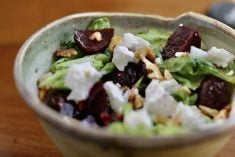The community I grew up in and the community I live in are both gathering information for history books. That brings conversations about how life used to be.
My mother recently gave me recipes that her older sister gave her. The recipes belonged to my great-grandmother and also to my grandmother who died when my mother was a teenager. The recipes were short and sketchy, not as detailed as recipes are today. I also remember as a young girl, using recipes with “rounded” and “level” teaspoon and tablespoon measurements.
Read Also

Communication key to bridging generation gap
Each generation is shaped by the predominant forces at play during their formative years. Acknowledging these influences can improve communication among the generations.
Several of the recipes include steaming. Because I wasn’t sure how they interpreted the word steam, I looked up the procedure in my old Canadian Cook Book by Helen Wattie and Elinor Donaldson, published by Ryerson Press, originally in 1923, with the 28th printing in 1963.
Steamed puddings, as described by Wattie and Donaldson, are favourite English desserts cooked in greased individual or large moulds or a Pyrex bowl. They must be tightly covered with metal foil or greased brown paper tied securely with string. Cook in a modern electric steamer or on a rack in a deep pot containing boiling water. The water level should be lower than the top of the pudding pot. Cover tightly and keep boiling gently. A steamer cooking trick that alerts you to dwindling water is to put two or three marbles or coins in the bottom of the steamer. They will make a racket until the water is gone; silence means it is time to add water.
My aunt Jean remembers eating this pudding when they were young, and she still makes it. She said grandma’s recipes didn’t cost much, but they always tasted good. The batter reminds me of the quick raisin pudding I usually cook in the oven, but this has a lighter texture.
Cup pudding (steamed)
2 eggs
1/2 cup butter 125 mL
3/4 cup sugar 175 mL
3/4 cup flour 175 mL
3/4 cup milk 175 mL
11/2 teaspoons baking powder 7 mL
1 teaspoon lemon extract 5 mL
Mix together and pour over fruit (apples, peaches, berries) in a greased dish. Steam a half hour. Serve with milk or the following sauce:
Caramel sauce
1 cup brown sugar 250 mL
1 heaping tablespoon flour 15-20 mL
1 tablespoon butter 15 mL
1 cup hot water 250 mL
Spanish rice
My mother often made Spanish rice when we were kids, but she didn’t have this recipe of grandma’s. Our seeding crew really liked this and asked for more.
Fry the following in butter:
1/2 onion
3 slices bacon, chopped
Add the following to the bacon and onion; put in an electric food steamer; then steam for one hour or more:
1 can tomatoes
1 cup milk 250 mL
1 cup cooked rice 250 mL
2 tablespoons sugar 30 mL
Mexican date pie
Dates are my favourite dried fruit, so of course I had to try this one.
1 uncooked pastry shell
1 cup milk 250 mL
2 eggs
1/2 cup (or less) white sugar 125 mL
1 cup cut-up dates 250 mL
Line the pastry shell with cut-up dates.
Beat together the eggs, milk and white sugar, and pour over the dates.
If you like, you can put an egg white meringue on top.
Place on the lowest rack of the oven in a 450 F (230 C) oven to start cooking of the pastry; then turn down to 325 F (160 C). Bake until custard is firm, for 35-40 minutes.
Chocolate cake
Mom made grandma’s recipe when I was at their house recently. It was light and fluffy. Mom said that this is the way cakes were in those days, unlike the heavier chocolate cake often made today.
Cream together first three ingredients:
1/2 cup butter 125 mL
1 cup brown sugar 250 mL
1/2 cup white sugar 125 mL
Add:
2 egg yolks (beaten)
Save the beaten egg whites to add at the end.
Add:
1/2 cup sour milk 125 mL
2 teaspoons baking powder 10 mL
1 teaspoon baking soda 5 mL
3 level tablespoons cocoa 45 mL
1/2 cup hot water 125 mL
2 cups flour 500 mL
pinch of salt
vanilla
Fold in the two beaten egg whites at this point.
Bake 30 minutes in moderate oven 350 F (180 C). Aunt Jean’s note on the side was that in the 1920s, 300 F (150 C) in the wood stove was quite hot. She said that her mom used a large black pan. My mother used a 12 x 8 inch (30 x 20 cm) pan.
Other old recipes
TEAM Resources received two old-fashioned cookbooks to experiment with and review. They are The Farmer’s Wife Cookbook and Ogilvie’s Book for a Cook.
The Farmer’s Wife Cookbook has more than 400 blue-ribbon recipes from Martha Engstrom. It was an interesting read that was hard to put down. At this time of year, I can identify with the following quote from 1912 inside the cover:
“The momentous question of ‘what shall we eat,’ which comes to the housekeeper three times every day and which must be met with a well-supplied table – whether everything else in the house goes undone – becomes monotonous and wearying. We hail suggestions as a ship-wrecked mariner does the distant sail.”
Although published in 2003 by Whitecap Books Ltd., this cookbook could have been from the early 1900s. Each chapter includes amusing and useful articles from the early 1900s. While much has changed, some advice remains the same. The recipes are true farm recipes that originated in country kitchens and were submitted by readers to The Farmer’s Wife, a monthly magazine published from 1893-1939 by Webb Publishing Co. of St. Paul, Minnesota.
I liked the following recipe because I remember having these when we were kids.
Baby porcupines
1 pound ground round steak 500 g
1 cup bread crumbs 250 mL
1 egg
4 tablespoons chopped onion 60 mL
salt and pepper
1/4 cup raw rice 60 mL
1 can (10 oz.) tomato soup 284 mL
2 cups boiling water 500 mL
Mix the meat, bread crumbs, egg, chopped onion, salt and pepper.
Shape into round oblong cakes and roll in the uncooked rice.
Heat the tomato soup and water in a Dutch oven. Place the cakes in this mixture and cover. Bring to a simmer and cook about one hour, and serve.
For more information, contact: Claire Wilson, Whitecap Books, 351 Lynn Avenue, North Vancouver, B.C., V7J 2C4, 604-980-9852, ext. 234, fax: 604-980-8197, e-mail: clairew@whitecap.ca.
The 1905 Ogilvie’s Book for a Cook was the first widely distributed Canadian flour company cookbook, published a decade or so before the Five Roses cookbook and Robin Hood Flour cookbook. The Ogilvie family was the first to export Manitoba’s hard spring wheat to Britain in 1885.
Whitecap Books has printed a 2003 edition with recipes that are tried, tested and proved, as well as pictures, illustrations and descriptions about the ingredients. Contact Monica Bisal, Whitecap Books, at the same information as above.
Barbara Sanderson is a home economist from Rosetown, Sask., and one of four columnists comprising Team Resources. Send correspondence in care of this newspaper, Box 2500, Saskatoon, Sask., S7K 2C4 or contact them at team@producer.com.














